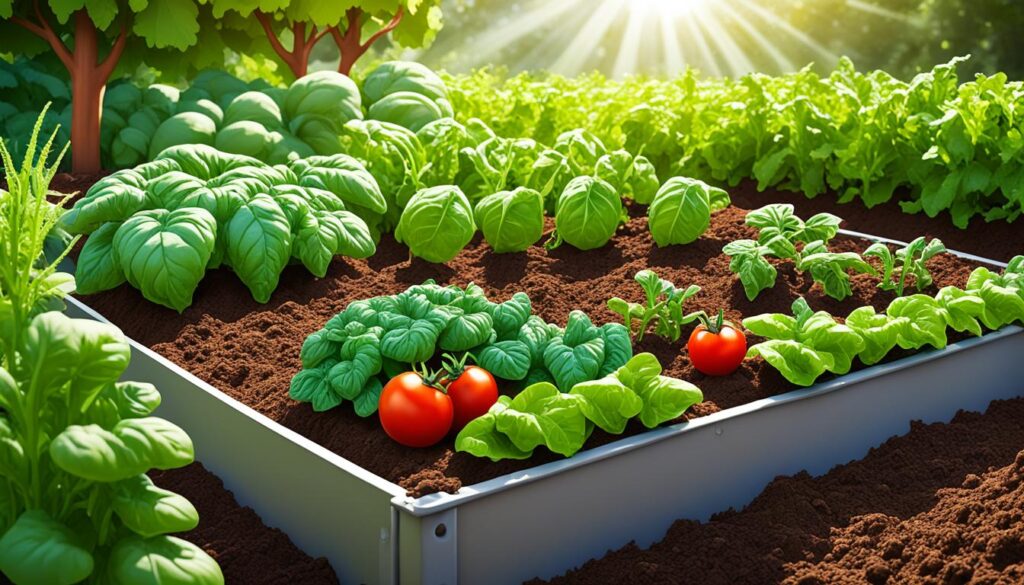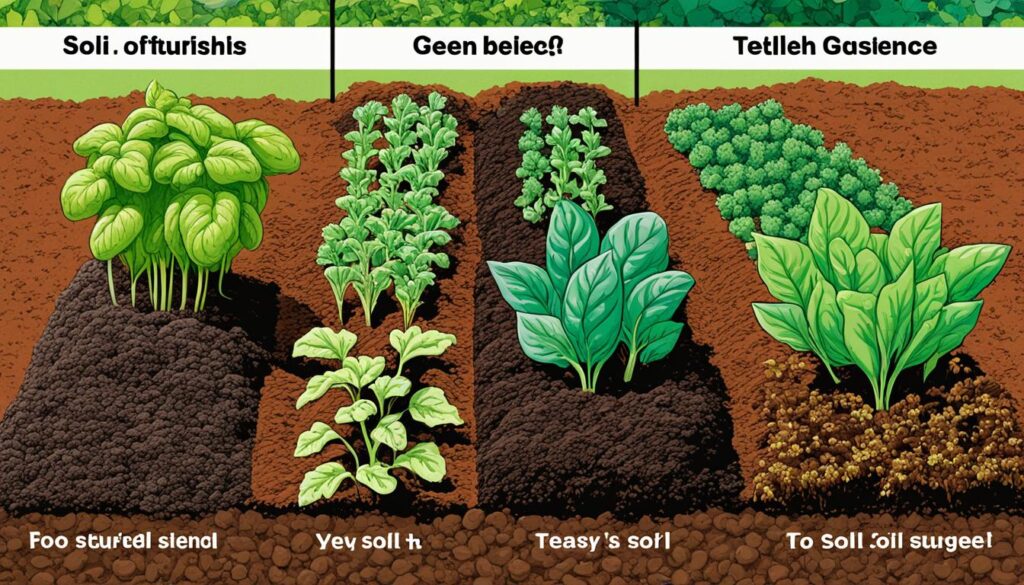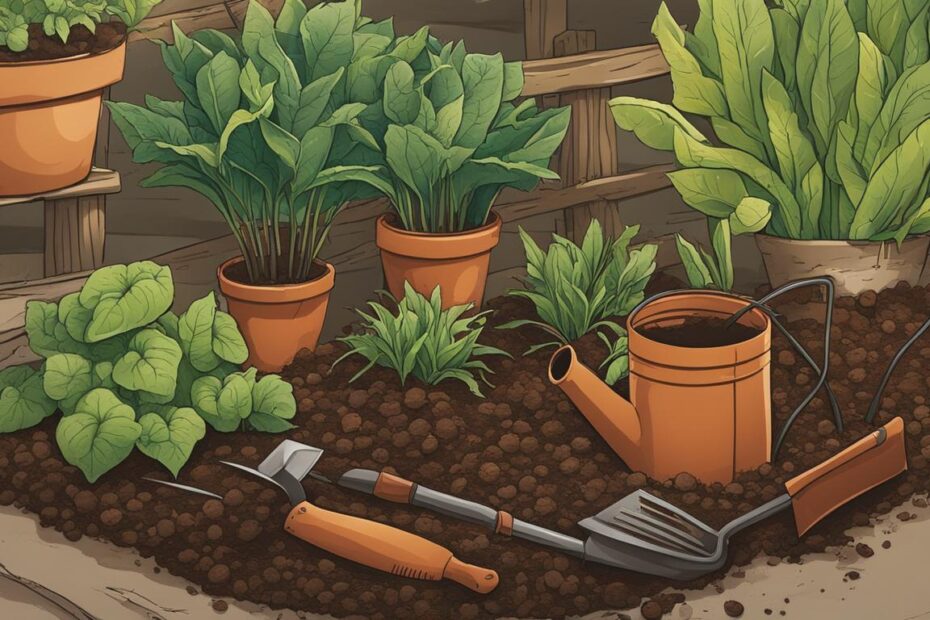When it comes to gardening, having the best soil is crucial for successful plant growth. But with so many options available, how do you know which garden soil to buy? Is the most expensive soil always the best? In this article, we will uncover the top choices for garden soil that will elevate your gardening experience and help you achieve thriving, abundant plants. Get ready to discover the soil secrets that will make your garden flourish!
Key Takeaways:
- Choosing the best garden soil is essential for successful plant growth
- Expensive doesn’t always mean better when it comes to garden soil
- Discover the top choices for garden soil that will make your plants thrive
- Uncover the secrets to achieving abundant and healthy plants
- Stay tuned for expert recommendations and valuable insights
The Benefits of Raised Bed Gardening
Raised bed gardening offers several advantages that make it a popular choice among gardeners. One of the key benefits is the ability to control the soil. If you have poor soil quality, rocky soil, or clay soil, raised bed gardening allows you to improve the soil by using a custom mix. Raised beds also prevent soil compaction and make it easier for gardeners to work without straining their backs. Additionally, raised beds provide better weed control and protect your plants from being walked on.
With raised bed gardening, you have the power to create the perfect environment for your plants. Customizing the soil means you can create an optimal blend that caters to the specific needs of your plants, such as adjusting the pH levels or adding organic matter. This ability to control the soil conditions leads to healthier plants and better overall growth.
Raised beds also offer practical benefits beyond just soil control. Due to their elevated design, raised beds are easier to access and manage compared to traditional gardens. This is especially beneficial for individuals with mobility issues or back problems. You can comfortably tend to your garden without having to bend over or kneel on the ground, reducing strain on your body.
Furthermore, the raised bed structure provides improved drainage for plants, ensuring that excess water can flow freely instead of pooling around the roots. This helps prevent waterlogged soil, which can lead to root rot and other plant diseases.
In addition, raised beds offer enhanced weed control compared to conventional gardening methods. The elevated design and clearly defined boundaries make it easier to spot and remove weeds before they can take hold and compete with your plants for nutrients and resources.
Lastly, raised beds protect your plants from foot traffic. By confining your garden to a raised bed, you can create clear paths around it, ensuring that no one accidentally steps on your precious plants. This is especially advantageous if you have children or pets who may inadvertently trample your garden.
The Best Soil for Vegetable Gardens in Raised Beds
When it comes to gardening in raised beds, having the best soil is essential for the success of your vegetable garden. The right soil mix will provide optimal drainage, moisture retention, and nutrient richness to support the healthy growth of your plants. In this section, we will explore the ideal soil composition to create the best environment for your vegetable garden.
The best soil mix for vegetable gardens in raised beds consists of a combination of three key components:
- Topsoil
- Compost
- Peat moss or coconut fiber
This blend of 1/3 topsoil, 1/3 compost, and 1/3 peat moss or coconut fiber provides a balanced mix that meets the needs of your vegetable plants. Let’s take a closer look at each component and its role in creating the best soil for your raised bed garden.
Topsoil
Topsoil forms the foundation of your raised bed. It should be nutrient-rich and well-draining. Look for high-quality topsoil that is free from contaminants and debris. You can source topsoil from local companies or mix your own with a combination of sand, clay, and organic matter.
Compost
Compost is a vital component of your soil mix as it adds essential nutrients, improves soil structure, and enhances moisture retention. Opt for well-rotted compost that is rich in organic matter. You can create your own compost by composting kitchen scraps, yard waste, and other organic materials, or purchase compost from local suppliers or garden centers.
Peat Moss or Coconut Fiber
Peat moss or coconut fiber, also known as coir, helps improve soil aeration, moisture retention, and drainage. These components prevent soil compaction and ensure the roots of your vegetable plants can breathe and access water and nutrients effectively. Large bales of peat moss or bags of coconut fiber are readily available at local hardware stores or garden centers.
Once you have gathered all the necessary ingredients, it’s time to mix them together to create the best soil for your raised bed vegetable garden. Use a wheelbarrow or large container to thoroughly blend the topsoil, compost, and peat moss or coconut fiber. Ensure that the mixture is well incorporated, and there are no clumps or pockets of unblended material.
To provide a visual representation of the recommended soil blend, here is a table summarizing the ideal ratios:
| Soil Component | Ratio |
|---|---|
| Topsoil | 1/3 |
| Compost | 1/3 |
| Peat Moss or Coconut Fiber | 1/3 |
Remember, it’s crucial to fill your raised bed completely with the soil mix to maximize plant growth and ensure sufficient sunlight exposure. Now that you have the recipe for the best soil mix, you are ready to create an ideal growing environment for your vegetable garden.

How to Fill a Deep Raised Bed Garden
When it comes to filling a deep raised bed garden, proper layering of materials is essential for optimal plant growth. Follow these steps to ensure a successful and thriving garden:
1. Prepare the Ground
If you are placing the raised bed on sod or weedy ground, layer cardboard on the bottom. This will help suppress weed growth and prevent them from invading your garden space.
2. Promote Decomposition
For deep beds, use logs or sticks along the bottom. This technique helps with drainage and promotes decomposition of organic material. On top of the logs or sticks, add a layer of organic material such as leaves, straw, or wood chips.
3. Start Filling with Soil Mix
Begin filling the bed with your chosen soil mix, compacting it gently as you go. The soil mix should consist of a well-balanced blend of topsoil, compost, and peat moss or coconut fiber.
4. Layer Compost, Topsoil, and Peat Moss
To create a nutrient-rich environment for your plants, layer compost, topsoil, and peat moss or coconut fiber in 2-inch increments until the bed is fully filled. This layering approach ensures that nutrients are distributed evenly throughout the soil.
5. Water the Soil
After filling the bed, thoroughly water the soil to help it settle and eliminate any air pockets. This will promote good root development and ensure proper moisture distribution.
By following these steps and properly filling your deep raised bed garden, you create an ideal environment for your plants to thrive and produce a bountiful harvest.
The Best Soil Mixes for Raised Garden Beds
When it comes to raised garden beds, choosing the right soil mix is essential for the success of your plants. There are several options available, but two popular choices are Mel’s Mix and the Perfect Soil Recipe.
Mel’s Mix, featured in the book “Square Foot Gardening,” is a well-balanced blend consisting of:
- 1/3 peat moss
- 1/3 vermiculite
- 1/3 compost
This combination provides optimal nutrition and drainage for plants in raised beds. Peat moss aids in moisture retention, vermiculite improves aeration, and compost enriches the soil with nutrients.
The Perfect Soil Recipe, recommended by Joe Lamp’l, is another effective option. It includes:
- 50% topsoil
- 30% compost
- 20% other organic matter
This mixture ensures a good balance of nutrients and organic content for healthy plant growth in raised beds.
| Soil Mix | Ingredients |
|---|---|
| Mel’s Mix | 1/3 peat moss, 1/3 vermiculite, 1/3 compost |
| The Perfect Soil Recipe | 50% topsoil, 30% compost, 20% other organic matter |
Both of these soil mixes provide the necessary components for healthy plant growth in raised garden beds. However, it’s important to note that bagged soil mixes can also be used. Just make sure to choose organic options specifically labeled for vegetable gardens to avoid any harmful chemicals.
Now that you have an understanding of the best soil mixes for raised garden beds, you can confidently prepare your beds with the right blend to support vibrant and thriving plants.
Tips for Amending Raised Bed Soil
Amending raised bed soil is essential for maintaining its fertility. Adding compost is a key step in improving soil quality and providing nutrients to plants. Consider creating your own compost pile or purchasing different types of compost, such as mushroom or shrimp compost, to enrich the soil.
It’s also beneficial to add chopped leaves in the fall and additional compost in the spring to replenish nutrients. Regular soil pH testing and the use of cover crops can further optimize the soil’s health.
Amending raised bed soil doesn’t have to be complicated. By incorporating compost, organic matter, and cover crops, you can nurture your soil and promote the growth of healthy plants.
Yield Comparison and Soil Test Results
In a year-long test comparing different raised bed soil mixes, the results revealed valuable insights into the productivity and health of plants. Not all soil mixes are created equal, and understanding the findings can help you make an informed decision about the best garden soil for your needs.
Yield Comparison:
When it came to yield, two soil mixes stood out from the rest. Mel’s Mix, a blend of 1/3 peat moss, 1/3 vermiculite, and 1/3 compost, demonstrated the highest yield. This mix provided optimal nutrition and drainage for plants, resulting in bountiful harvests. The second-best performer was the Perfect Soil Recipe recommended by Joe Lamp’l, consisting of 50% topsoil, 30% compost, and 20% other organic matter.
“Mel’s Mix had the highest yield, followed by the Perfect Soil Recipe”
It’s worth noting that the bagged soil mix, while convenient, showed signs of poor plant health and had the lowest yield. This emphasizes the importance of selecting the right soil mix to provide the necessary nutrients and conditions for successful gardening.
Soil Test Results:
Soil tests conducted on the different raised bed soil mixes revealed variations in pH levels and nutrient content.
- Mel’s Mix had a slightly acidic pH, which is favorable for most plants.
- The Perfect Soil Recipe had a neutral pH, providing an excellent balance.
- The bagged soil mix had a higher pH, which may have affected plant growth negatively.
Understanding the pH of your soil is crucial as it influences nutrient availability to plants. Additionally, variations in nutrient content were observed among the different mixes, highlighting the importance of selecting a soil mix that provides adequate nutrition for your plants.
Here are the key takeaways from the yield comparison and soil test results:
- Mel’s Mix and the Perfect Soil Recipe demonstrated superior yields.
- Soil pH varied among the different mixes, with the bagged soil mix having a higher pH.
- Proper nutrient content is essential for healthy plant growth.
Considering the yield comparison and soil test results will guide you in selecting the best garden soil for optimal plant growth and abundant harvests.
| Soil Mix | Yield | pH Level | Nutrient Content |
|---|---|---|---|
| Mel’s Mix | Highest yield | Slightly acidic | Rich in nutrients |
| Perfect Soil Recipe | Second-highest yield | Neutral | Well-balanced nutrient content |
| Bagged soil mix | Lowest yield | Higher pH | Lower nutrient content |

Conclusion
Choosing the best garden soil is essential for successful gardening. With raised bed gardening, you have the opportunity to take control of your soil and create the perfect environment for your plants to thrive. By using a combination of topsoil, compost, and either peat moss or coconut fiber, you can provide your vegetable garden with a well-draining soil that retains moisture and is rich in nutrients.
Filling deep raised beds with the right soil mix is crucial. Layering the materials properly, including cardboard to suppress weed growth, and compacting the soil as you go, will ensure even distribution and help your plants establish strong roots. Amending your raised bed soil with compost and organic matter, such as chopped leaves and cover crops, will enhance its fertility and provide ongoing nourishment for your plants.
Consider the yield comparisons and soil test results when selecting the ideal garden soil. In a year-long test, Mel’s Mix and the Perfect Soil Recipe showed the highest yields, while the bagged soil mix performed poorly. Soil pH levels and nutrient content also varied among the different mixes, highlighting the importance of understanding your soil’s characteristics. By choosing the right garden soil, you can cultivate a thriving garden and enjoy bountiful harvests season after season.
FAQ
Why is raised bed gardening beneficial?
Raised bed gardening allows for better soil control, prevents soil compaction, provides better weed control, and protects plants from being walked on.
What is the best soil mix for vegetable gardens in raised beds?
The best soil mix consists of 1/3 topsoil, 1/3 compost, and 1/3 peat moss or coconut fiber.
How should I fill a deep raised bed garden?
Layer cardboard on the bottom to suppress weed growth, use logs or sticks along the bottom with organic material on top, and then fill the bed with the soil mix.
What are some recommended soil mixes for raised garden beds?
Mel’s Mix from the book “Square Foot Gardening” consists of 1/3 peat moss, 1/3 vermiculite, and 1/3 compost. The Perfect Soil Recipe consists of 50% topsoil, 30% compost, and 20% other organic matter.
How can I amend raised bed soil?
Add compost, such as mushroom or shrimp compost, to enrich the soil. Use chopped leaves in the fall and additional compost in the spring. Regular soil pH testing and the use of cover crops can also help optimize soil health.
What were the results of the yield comparison and soil tests?
Mel’s Mix had the highest yield, followed by the Perfect Soil Recipe. The bagged soil mix had the lowest yield and showed signs of poor plant health. Soil tests revealed variations in pH levels and nutrient content among the different mixes.
